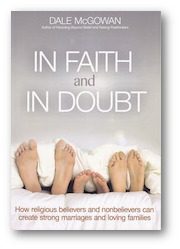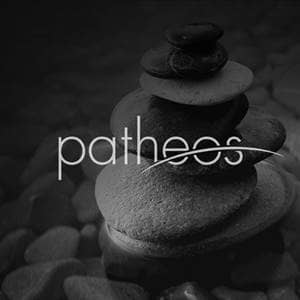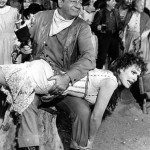By Dale McGowan
Not long ago, marriages in the U.S. tended to be religiously uniform. Catholics married Catholics, Lutherans married Lutherans — and the nonreligious were a vanishingly small part of the cultural landscape.
The picture is more interesting today. Mixed-belief marriages in the U.S. have more than doubled from 19% in 1960 to 39% today — and the nonreligious are a large and growing part of that mix. Forty-four percent of the religiously unaffiliated who are married have partners with a specific religious identity.
Marriages between religious believers and nonbelievers are sometimes a nightmare of tension and conflict. Some end in divorce as a direct result of the religious difference. But many others are strong and lasting, with very little tension and conflict. So why do some fail miserably and others succeed brilliantly?
While writing my book In Faith and in Doubt: How Religious Believers and Nonbelievers Can Create Strong Marriages and Loving Families, I surveyed nearly 1,000 people in secular/religious relationships and interviewed couples of many different configurations and outcomes. Over time, some solid patterns emerged — elements typical of low-tension, enduring relationships between religious and nonreligious partners, and elements typical of relationships marked by high tension and conflict, including many that had already ended as a result.
If you’re currently in a secular/religious relationship or are considering one, here are 10 ways to put the odds in your favor.
1. Never try to convert or de-convert your partner. In matters of belief, support and encourage your partner’s autonomy.
If your partner wants to question or challenge his or her own opinions and wants a sounding board, he/she knows where to find you. No problem discussing and challenging each other’s ideas. But if you want a mixed-belief relationship to work, let your partner know that in the end you respect his or her right to self-determination.
2. Talk about your differences of belief as early as possible in the relationship.
Relationships should be entered into with all cards on the table. Sharing a difference in belief with a partner or potential partner as early as you can demonstrates honesty and respect. You don’t have to reveal your whole personal history on the first date, but when things start getting serious—and certainly before engagement, marriage, kids—it’s best to discuss the difference openly.
3. Define your negotiables and non-negotiables.
Each partner might have a long list of preferences related to religious or nonreligious practice — churchgoing, parenting, family religious identity, and so on. Which are negotiable for each of you, and which are not? Decide what you can live with and without, and what you cannot, then compare lists for potential conflicts.
4. Focus on shared values more than different beliefs.
We tend to focus tightly on differences in belief, many of which are theological abstractions. But values (opinions about what is good and important) impact daily life more intensely than most beliefs. Moderate and liberal believers and nonbelievers share more values with each other than either shares with the more extreme representatives of their respective worldviews.
5. Make personal respect non-negotiable, even if you question and challenge each other’s ideas.
Ideas and opinions must earn respect, but respect for each other as people is a non-negotiable requirement of any relationship. If separating the two is not possible, a mixed-belief relationship might not be for you.
6. Engage in and learn about each other’s worldviews.
Make an effort to learn more about your partner’s worldview, not only on paper but by talking to your partner and having shared experiences in both traditions to whatever extent you are comfortable. It’s a huge gesture of personal respect and a way to deepen your mutual understanding.
7. Remember that the opinions of believers are not always the same as the doctrines of their churches, and the opinions of nonbelievers are not always the same as those of prominent atheists.
The marriage of a believer and nonbeliever is not a marriage of the Bible and The God Delusion. Most religious people aren’t Old Testament literalists, and most nonreligious people don’t think religion poisons everything. Take the time to find out whether and how your partner’s beliefs differ from the stereotype.
8. Raise children with the freedom to choose their own religious or nonreligious identity. Expose them to many traditions, beliefs, and practices.
If parents have two different worldviews, there is one clear best practice for the kids: keep them unlabeled, then preserve space around them so they can come to their own conclusions in the long run. Provide knowledge and experience to fuel that process, and let them know you will never withhold your love and support, no matter how they decide these questions. Progressive believers and nonbelievers alike embrace this idea to a greater extent than either tends to assume of the other.
9. Support and protect each other from mistreatment or disrespect, especially by those who share your worldview, including extended family.
If your partner is being maligned, pressured, or ostracized by family or community members because of his or her beliefs, a mixed-belief partner is in a unique position to come to his or her defense. Never miss an opportunity to do so.
10. Spread the word.
If you are married to someone across the gap between religious belief and nonbelief, you’re in a unique position to dispel negative stereotypes about your partner’s worldview. The religious partner can be a moderating voice when the church ladies start suggesting that all atheists are immoral, and the nonreligious partner can do the same when those in the local atheist group suggest that all religious people are unintelligent. You know better, so find the courage to speak up.
There are no guarantees, but these practices correlate highly with couples in functional, satisfying, lasting relationships across the biggest belief gap of all.
 Excerpt from In Faith and in Doubt: How Religious Believers and Nonbelievers Can Create Strong Marriages and Loving Families by Dale McGowan (AMACOM, 2014)
Excerpt from In Faith and in Doubt: How Religious Believers and Nonbelievers Can Create Strong Marriages and Loving Families by Dale McGowan (AMACOM, 2014)
DALE McGOWAN is the author of several books from the nonreligious perspective. He was Harvard Humanist of the Year in 2008 and founded the humanist charity Foundation Beyond Belief in 2010. He is currently Content Development Editor and Atheist Channel Managing Editor for Patheos. He lives in Atlanta.














